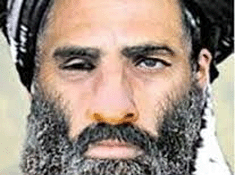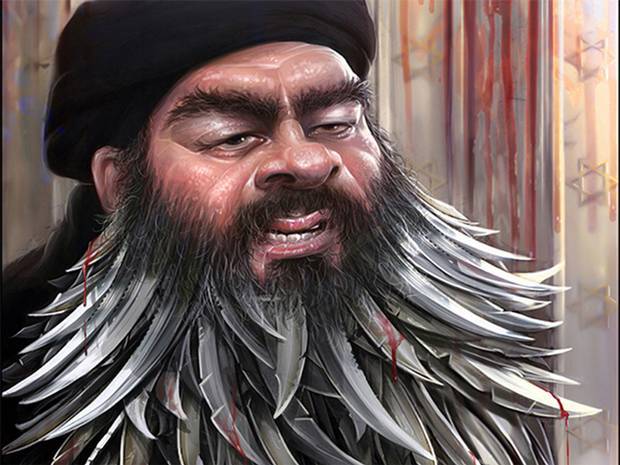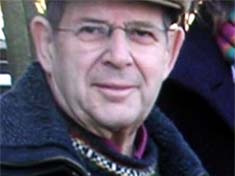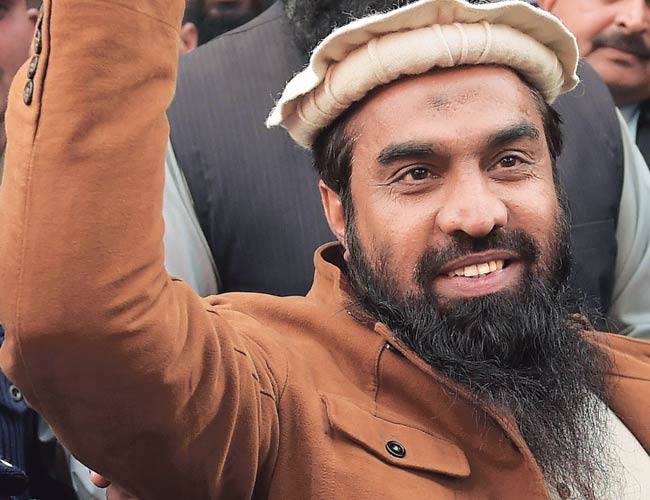Suspect in Bhutto attack freely pursues jehadi agenda

Islamabad: (The News) Eight years after the October 18, 2007 Karsaz suicide bombings targeting Benazir Bhutto Shaheed’s homecoming procession in Karachi, Qari Saifullah Akhtar, the ameer of the Harkatul Jehadul Islami (HUJI), who had been named by Mohtarma in her posthumous book as the key suspect in the Karsaz attacks, remains at large and keeps pursuing his radical agenda freely after being set free from jail.
Around 150 people were killed and hundreds others wounded when two suicide blasts in quick succession ripped through the procession as it reached the Karsaz area at midnight. Although Ms Bhutto had survived the Karachi attack, she was assassinated in the garrison town of Rawalpindi almost ten weeks later on December 27, 2007. Almost two weeks after her martyrdom, Ms Bhutto had named the ameer of al-Qaeda and Taliban-linked outfit, Qari Saifullah Akhtar, in her posthumous book as a principal suspect in the attempt to kill her in Karachi on October 18 2007. Shortly before her assassination, Ms Bhutto was giving final touches to her hard-hitting memoirs entitled, Reconciliation: Islam, Democracy and West, which was published by Simon & Schuster six weeks after her death.
The bomb explosions were powerful enough to rip off a door of her truck; what saved Benazir Bhutto was that she wasn’t atop the truck at that fatal moment. Subsequent investigations revealed prior knowledge of the security architecture around Benazir. Not only was the attack three-pronged, the mastermind chose suicide bombers to evade the jamming devices fitted into two vehicles immediately in front and behind her truck. The jammers could have prevented any blast triggered by a remote-controlled device, as had happened during one of the two attempts on Musharraf’s life in December 2003 in Rawalpindi. The nature of the explosives used in the twin attacks indicated highly intricate planning. Investigations revealed that the bombers had strapped themselves with 15-20 kg of a fiery mix of C4 and Trinitrotoluene explosives.
So, who were the people having access to such devastating and rarely available explosives and being aware of the obstacles they would encounter in targeting Bhutto? In her book, Benazir Bhutto herself stated, It was Qari Saifullah Akhtar to whom his handlers had turned to for help before her homecoming on 18 October 2007. Although no one is sure if there was a link between the release of Qari and the murder of Bhutto, the PPP circles ask why an al-Qaeda linked dreaded terrorist having known links with the Taliban militia was set free after three years in imprisonment, shortly before her homecoming. The clandestine release, months before her return [in May 2007], therefore, evoked suspicions among PPP circles of a nexus between Qari Saifullah and the Musharraf regime. And one must remember that Qari has always been regarded by his handlers as an asset who had been involved in the 1995 failed attempt to stage a coup against the Bhutto government, but was given a safe passage after becoming an approver.
Benazir Bhutto wrote in her book: ‘I was informed of a meeting that had taken place in Lahore where the bomb blasts were planned. However, a bomb maker was needed for the bombs. Enter Qari [Saifullah Akhtar], a wanted jehadi terrorist who had tried to overthrow my second government in 1990s. He had been extradited by the United Arab Emirates and was languishing in the Karachi central jail. According to my sources, his handlers had turned to Qari [Saifullah] for help. His liaison with his handlers was a radical who was asked to make the bombs and he himself asked for a fatwa making it legitimate to oblige. He got one. The bomb blasts took place in the army cantonment area in Karachi”.
On February 26, 2008 two weeks after Bhutto’s revelations, the Musharraf regime had arrested Qari Saifullah Akhtar for the purpose of interrogations, although there were many who believed that the Qari has actually been taken into protective custody by his handlers. As a matter of fact, Qari is generally considered to be a handy tool of his handlers who is used and dumped whenever required by them. The Qari was seized by the security agencies along with his three sons (Asif Ali, Abdul Rehman and Mureed Ahmad) in Ferozewala, near Lahore. He was grilled by a joint interrogation team comprised of operatives from the Punjab Police, Inter Services Intelligence and the Special Investigation Group of the Federal Investigation Agency.
During interrogations, Qari claimed that he had already adopted the path of Sufism since his May 2007 release and was living for the past few months in the Khanqah (Sufi retreat) of a renowned Sufi cum militant of the 18th century, Syed Ahmad Shaheed (born 1786 died 1831). Although Syed Ahmed’s tomb is situated in Balakot, his followers have established a Khanqah in his name near the Sagian Bridge in the Ferozwala area, close to Lahore, from where he was seized. Qari told his interrogators that upon his release, he went to Masjidul Huda lane Hamza Town, Lahore to meet his Pir (spiritual mentor), Syed Nafees Shah, also a follower of Syed Ahmed Shaheed, who ordered him to stay in the Ferozwala Khanqah and work for the spiritual guidance of the people.
Qari also conceded that his failed ‘Operation Khilafat’ of 1995 to topple Bhutto’s second government with the help of his like-minded armymen, was meant to bring in Khliafat system in Pakistan and to enforce Shariah in accordance with the teachings of Syed Ahmed Shaheed. Qari told his interrogators that his Pir (mentor) Syed Nafees Shah had declared him ‘Khalifah’ in his place, shortly before his February 5, 2008 death and he was duty bound to fulfill his mission of converting Pakistan into a pure Islamic state, to be ruled by a Khalifah who has the traits of both Syed Ahmed Shaheed and Ahmad Shah Abdali.
Born on January 8, 1959 in South Waziristan, Qari Saifullah is a graduate of the Jamia Binoria in Karachi. He was arrested and extradited from the United Arab Emirates on August 7, 2004 on charges of plotting twin suicide attacks on Musharraf in Rawalpindi in December 2003. However, instead of trying to prosecute and convict him after his arrest, he was kept under detention for the next two years and nine months, without even filing any criminal charges against him. His “unprovoked” arrest was challenged in the Supreme Court of Pakistan in the first week of January 2005. On January 18, 2005, the Supreme Court dismissed the petition against Qari’s arrest and directed the petitioner to first move the High Court by filing a habeas corpus writ petition. A Supreme Court bench ruled that the arrest in this case was not a matter of public importance and hence a constitutional petition could not be filed directly in the Supreme Court under Article 184(3) of the Constitution. However, following Benazir’s murder, it emerged that Qari was quietly released as one of the missing persons being sought by a Supreme Court bench headed by the then Chief Justice Iftikhar Chaudhry.
Before that, on 5 May 2007, the federal government told the Supreme Court that Qari Saifullah was not in the custody of the state agencies. The concise report presented by the National Crisis Management cell to the Supreme Court revealed: “He is engaged in jehadi activities somewhere in Punjab,” thus denying that he was under detention. Two weeks later, on May 21, 2007 Qari Saifullah suddenly reached his hometown in Mandi Bahauddin, with the national media reporting on May 22, 2007 that Qari Saifullah was actually released earlier that morning when he was thrown out of an official car in a deserted area near the Chakwal district. The release was subsequently brought into the notice of the apex court on May 26, 2007 by the Ministry of Interior.
Hashmat Habib, the counsel for Qari Saifullah Akhtar, having confirmed the release of his client, told the Supreme Court that while setting him free, his client was told that had they not picked him up, there was a strong possibility of the US Federal Bureau of
Investigation (FBI) taking him away for interrogations because of his alleged al-Qaeda and Taliban links. At the time of his August 2004 dramatic arrest and subsequent extradition, the Pakistani authorities had described the development as a major blow to the al-Qaeda sponsored terrorist network and its local affiliates in Pakistan. The then Information Minister Sheikh Rashid Ahmed went to the extent of painting him as a close aide of Osama bin Laden and Mullah Omar, and the operational head of al-Qaeda in Pakistan. ‘We confirm that we have arrested Qari Saifullah Akhtar. He was on our wanted list for a long time”, he had stated during a news conference.
On March 20, 2008, almost three weeks after his February 26, 2008 arrest, Qari Saifullah was produced before Anti-Terrorism Court in Karachi for his involvement in the October 2007 attacks on Benazir Bhutto’s procession. Justice Khawaja Naveed subsequently granted 12 days’ remand to the Karachi police till March 29, 2008 so that Qari could be grilled thoroughly. On March 20, 2008, Hashmat Habib, the counsel of Saifullah, told the media in Karachi that he had sued the printer, publisher and beneficiaries of Benazir Bhutto’s book for falsely accusing his client of being involved in the Karachi bombing and thus damaging his reputation. ‘I have moved the suit under Section 8 of the Defamation Ordinance 2002 … seeking damages of $200 million.
Five days later, on March 26 Justice Khawaja Naveed Ahmed ordered the release of Qari on bail after the investigation officer reported to the ATC that no evidence had been found to link him with any terrorist activity. Investigation officer Nawaz Ranjha submitted a report to the court stating that during initial investigations he did not get enough evidence to file a charge sheet against Qari. ‘The suspect was interrogated during the 12-day period given by the court but he denied involvement in the blasts. Under Section 497 of the Criminal Procedure Code, when a person accused of a non-bailable offence is arrested without warrant by an officer-in-charge of a police station, he may be released on bail when he is brought before a court, but he shall not be so released if there are reasonable grounds to believe that he is guilty of an offence punishable with death or imprisonment for life or imprisonment for 10 years,’ so stated the report submitted to the court.
Although the judge accepted the report and ordered Qari Saifullah’s release on bail, Qari was rearrested under the Maintenance of Public Order (MPO) and shifted to a Karachi safe house. Two months later, on June 8, 2008, Qari was released by the Sindh Home Department when the term for his detention expired. ‘He is a free person. There is no case against him anywhere in Pakistan,’ Qari’s lawyer told the media. Subsequent media reports indicated that Qari had shifted his jehadi base to Waziristan by the end of 2008. In August 2010, the national media reported that Qari Saifullah has been arrested from Chishtian district of Punjab, as he had abandoned Waziristan after being wounded in a US drone attack. But he was set free on the orders of the Punjab home department almost three months later in December 2010, on the third death anniversary of Benazir Bhutto’s assassination.
Eight years after Benazir Bhutto’s assassination, Qari Saifullah Akhtar is no more in the spotlight. However, the fact remains that the elusive Qari lives freely in Ferozwala near Lahore and keeps pursuing his radical agenda unchecked by indoctrinating more and more people at Syed Ahmed Shaheed’s Khanqah or Sufi retreat.
http://www.thenews.com.pk/Todays-News-6-346457-Suspect-in-Bhutto-attack-freely-pursues-jehadi-agenda




